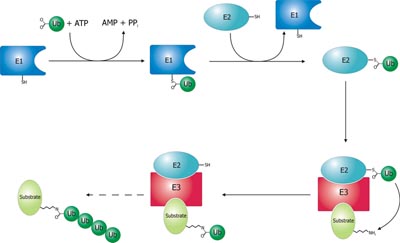 Angelman syndrome is a severe neurodevelopmental disorder that is caused by a mutation in the UBE3A gene. This affects the production of the E3 ubiquitin ligase, an enzyme that selectively marks proteins for degradation. A balance between synaptic proteins and their degradation is essential for normal neural transmission and plasticity. When the Ube3A enzyme is not made in the brain it causes a loss of synaptic plasticity and this loss is accelerated by simply using the synapses. A study published last year in Nature Neuroscience (Yashiro et al., 2009) showed that synapses in the cortex of Ube3A knockout mice become rigid and do not function normally.
Angelman syndrome is a severe neurodevelopmental disorder that is caused by a mutation in the UBE3A gene. This affects the production of the E3 ubiquitin ligase, an enzyme that selectively marks proteins for degradation. A balance between synaptic proteins and their degradation is essential for normal neural transmission and plasticity. When the Ube3A enzyme is not made in the brain it causes a loss of synaptic plasticity and this loss is accelerated by simply using the synapses. A study published last year in Nature Neuroscience (Yashiro et al., 2009) showed that synapses in the cortex of Ube3A knockout mice become rigid and do not function normally.This description of rigid synapses and loss of plasticity lead my research group (Williams et al., 2010) to ask if a loss of Ube3A is part of normal aging. Abnormal ubiquitinated proteins are characteristic of many neurodegenerative disorders, including Alzheimer's and Parkinson's disease. Furthermore, longevity studies have shown that Ube3A is necessary for a caloric restriction diet to increase lifespan. So what happens during normal aging?
We found that both animal and human brains lose Ube3A across the lifespan. But the loss in human brains is different. During aging of the human brain there is a greater loss of Ube3A than other synaptic proteins. This points to a specific vulnerability in the aging human human brain that may lead to rigid synapses, loss of plasticity, and decline of cognitive function.
There is, however, a key difference between between the Angelman mice and human aging. In Angelman mice plasticity is preserved by restricting experience. But the best way to preserve function during normal aging is to engage in activities that keep the mind and body active. Clearly, the loss of Ube3A during aging of the human brain must be more complicated that just losing Ube3A at all synapse. This raises the intriguing possibility that Ube3A is lost at some synapses and not others during aging.
It will be important to determine what drives the loss of Ube3A during aging of the human brain and if certain circuits are more vulnerable than others. But perhaps more pressing is to figure out if the loss can be prevented. Encouraging results from a recent study (Greer et al., 2010) show that enriched experience in adult mice increases Ube3A expression in an important memory center in the brain (hippocampus).
So keep trying new things and expanding your range of experiences. Who knows it just might help the Ube3A in your brain.
Dramatic loss of Ube3A expression during aging of the mammalian cortex
Kate Williams 1, David A . Irwin 1, David G . Jones 1 and Kathryn M. Murphy 1, 2*
1 McMaster Integrative Neuroscience Discovery and Study Program, McMaster University, Canada
2 Psychology, Neuroscience&Behaviour, McMaster University, Canada
Greer, P. L., Hanayama, R., Bloodgood, B. L., Mardinly, A. R., Lipton, D. M., Flavell, S. W., Kim, T. K., Griffith, E. C., Waldon, Z., Maehr, R., Ploegh, H. L., Chowdbury, S., Worley, P. F., Steen, J., and Greenberg, M. E. (2010). The Angelman Syndrome protein Ube3a regulates synapse development by ubiquitinating arc. Cell 140, 704–716.
Yashiro, K., Riday, T., Condon, K., Roberts, A., Bernardo, D., Prakash, R., Weinberg, R., Ehlers, M., and Philpot, B. (2009). Ube3A is required for experience-dependent maturation of the neocortex. Nat. Neurosci. 12, 777–783.





Comments